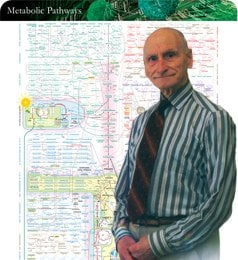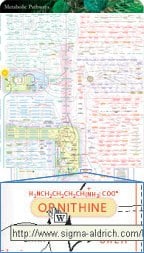Metabolic Pathways
Remembering Dr. Donald Nicholson, 1916–2012

Dr. Donald Nicholson received his B.Sc. in 1936 and his Ph.D in 1940, both in Chemistry from London University. He then went to work at Boots Pure Drug Company at Nottingham on the development and production of the earliest sulphonamide antibacterial drugs. In 1946 he joined the department of Bacteriology at the School of Medicine in Leeds as an I.C.I Fellow in Chemotherapy and remained there as Lecturer or Senior Lecturer in Microbiology until "retirement" in 1981. Even into his 90s, Dr. Nicholson was actively engaged in the creation of smaller and more detailed "minimaps" and especially "animaps". In recognition of his work, he received an Honorary D.Sc. and was made one of only two Honorary Life Members of the IUBMB.
Learn more about Dr. Nicholson and how he created the Metabolic Pathway Charts.
22nd IUBMB-Nicholson Metabolic Pathways Chart

Publication DataDesigned by Donald Nicholson Prepared and published by Sigma-Aldrich Co. LLC, St.Louis, MO ©2002 International Union of Biochemistry and Molecular Biology
The Metabolic Pathways Map contains over 500 hyperlinks to our product listings. Just click on the metabolite name or the enzyme's E.C. number to access product information.
The 22nd (2003) edition of the IUBMB-Nicholson Metabolic Pathways Chart contains updated pathways involved in ATP metabolism in the mitochondria and chloroplast. The "backbone" of the map is the Glycolytic Pathway followed by the TCA (Krebs) Cycle and the Respiratory Chain which together lead to the synthesis of ATP by ATP Synthase. ATP is the source of most of the energy required for all life. Many biosynthetic and breakdown pathways of metabolism such as carbohydrates, amino acids, lipids are associated with this backbone and are differentiated by the use of color. Human metabolism is distiguished where possible by the use of black arrows. Some 550 reactions are identified by their IUBMB Enzyme Commission (EC) numbers which are then indexed.
View Chart (3.05 Mb PDF) — Use Adobe Reader's Zoom-In Tool when viewing chart.
The 22nd edition of the comprehensive Metabolic Pathways Chart. Features glycolysis, carbohydrate, amino acid, lipid, nucleotide, steroid, vitamin metabolism and much more.
Order Your Copy Today!
Minimaps (PDF) and Related Resources
The 22nd edition is now supplemented on-line by Minimaps which take selected individual pathways and enlarge them to illustrate aspects of metabolism that could not previously be shown – such as compartmentalization and regulation.
Complete List of Enzyme Commission Numbers on the Metabolic Pathways Chart
This table cross references the names of all the enzymes to the corresponding E.C.#s on the Metabolic Pathway Charts.
IUBMB-Nicholson Minimaps
Selected individual pathways have been enlarged to illustrate aspects of metabolism that could not previously be shown, such as compartmentation, enzymes and regulation.
Animated Metabolic Pathways
A unique and exciting development is the introduction of animated metabolic pathways - "animaps" to the IUBMB-Nicholson pathways series. Biochemistry thus becomes more clearly biochemistry and Metabolism becomes more "meaningful, wonderful and fun!" These animations have no sound.
Electron Transport Animation
An animated representation of how the protonmotive force is generated in mitochondria to drive ATP synthase.
ATP Synthase Animation
An animated representation of the mechanism of what many consider to be the most important molecule to living systems.
Glycolytic Pathway Animation
An animated representation of the reactions that convert glucose into pyruvate.
TCA Cycle Animation
This video shows the stages of the citric acid cycle and keeps track of products and reactants as the intermediate steps progress and complete the reaction (and chemical equation).
Pyruvate Dehydrogenase Complex Animation
An animated representation of how pyruvate from the cytosol links to Acetyl-CoA and the TCA Cycle in the Mitochondrial Matrix. This animation requires Adobe Flash player.
To continue reading please sign in or create an account.
Don't Have An Account?